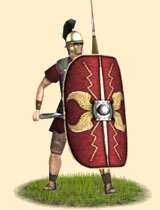Prima Cohors Reformata (Marian Legionary First Cohort)
 |
Weapons | Defence | Mental | ||||||
|---|---|---|---|---|---|---|---|---|---|
| Primary | Secondary | Armour: | 10 | Morale: | 15 | ||||
| Type: | spear | sword | Shield: | 4 | Discipline: | disciplined | |||
| Attack: | 5 | 11 | Skill: | 10 | Training: | highly_trained | |||
| Charge: | 4 | 4 | Recruitment | Other | |||||
| Lethality: | 1 | 0.13 | Soldiers: | 50 | Hit Points: | 1 | |||
| Range: | 36.8 | 0 | Cost: | 1914 | Mass: | 1.2 | |||
| Ammo: | 2 | 0 | Upkeep: | 479 | |||||
| Turns: | 1 | ||||||||

The first cohort contains the aquilifer, the bearer of the legion’s eagle standard, the primary symbol of roman power and an inspiration for all roman soldiers nearby.
The first cohort of each legion contains the aquilifer, the bearer of the eagle standard, the primary symbol of roman power. Nothing is more dishonouring than its loss and the eagle’s presence inspires the legionnaires nearby, especially if it is carried ahead of the advancing lines into the heart of battle.
Roman legionnaires are now uniformly equipped with two pila, a gladius, and an elliptical scutum around 1.28m high. Their main armour remains a coat of lorica hamata (chain mail) and a Montefortino-type helmet. The high quality of legionary equipment is one of the great strengths of the Roman infantry, besides their strict discipline. In battle they will throw their pila as soon as the enemy comes in range to soften his formation and then engage at close quarters.
Historically, Gaius Marius is credited with introducing the eagle as the legion’s sole standard, to increase the identification of the soldiers with their legion and the bond between them. Previously every legion had five: a boar, a minotaur, a wolf, a horse and an eagle, but at the end of the 2nd century BC it was already common practice to carry only the eagle into battle. Later in the first century BC, when the legions slowly transformed into permanent institutions the eagle gained great importance in their ideology and become an almost sacred item, and the “dies natalis aquilae” (birthday of the eagle), the founding day of the legion, is it’s yearly celebrated most important holiday.
The organization of the legion began to change at the end of the 2nd century BC and in the early 1st century BC all but the heavy infantry had disappeared. The Hastati, Principes and Triarii were now all uniformly equipped and only their names remained. Three maniples, each increased in size to 160 men, now formed one cohort, the new main tactical unit of the Roman infantry, besides the now 80 men strong centuria. However, often the late republican legions did not reach their theoretical strength, and around 400 men per cohort was far more common. These changes offered much more tactical flexibility to the legion. Instead of being limited to a three-line battle formation, the soldiers could be positioned as easily in one, two, or even more lines. A cohort was big enough to operate separately from the main army, to perform smaller tasks independently.
To reduce the legion's vulnerable baggage train and increase troops’ mobility, the legionnaires now had to carry as much of their equipment as possible by themselves. They received the nickname “mules mariani”, the "mules of Marius," for the load they carried, nearly 50 Kg in all. The long time they normally had to serve made it possible to train all soldiers to an equally high standard in the whole army. This, and the heavy load they had to carry, gave them their unrivalled endurance. Experts in siege warfare, artillery, and other engineering specialists could be found in the ranks of the legion, and all contubernia, the eight men strong basic logistical unit of the army, were equipped with tools and valli for the fast construction of field fortifications.
After these changes the Roman legionary could easily be considered the most disciplined and most versatile heavy infantryman in the world.
The problem of the late republic to find enough men who fulfilled the property requirements to serve as heavy infantry in the many and continuous wars the masters of the Mediterranean world now had to fight was one of the main reasons that reforms in the army had become inevitable. Earlier attempts to increase the number of suitable small farmers through land reforms by the Gracchi were blocked by senate, as many senators owned great latifundia now sprawling all over Italy. So all property requirements were given up and volunteers from all social classes were welcomed as well as the conscripts, while the state or their generals paid for their equipment. The senate had refused to bear the incalculable able costs for the veterans so that the generals had to take care of them. The loyalty of these men shifted more and more to charismatic leaders that they were now depending on, preparing the ground for many bloody civil wars of the 1st century BC.